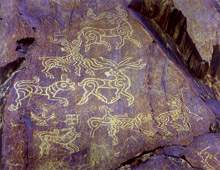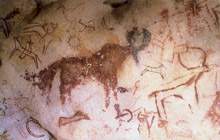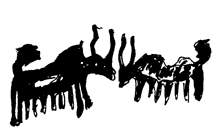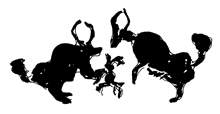
Rock Paintings in China
Rock paintings in China can be divided into southern and northern schools.
Southern school rock paintings depict mainly religious rituals and are painted in red. They are distributed in an area from southwest to south China.
Northern school rock paintings, carved into rocks, show hunting activities in north China. They are distributed in an area from the northeast to northwest and southwest. The part from northeast to southwest China extends from Heilongjiang to Inner Mongolia, Ningxia, Gansu, Qinghai, Xinjiang and Tibet. Once in Inner Mongolia,
Leopard Chases Dear:Carved rock painting in Renmodong
the rock paintings moved northwestward in two ways: one way connected with Central Asia via Altaishan, Tianshan and Kunlunshan Mountains, and the Pamir Plateau; the other way linked up with Central Asia via Yingshan, Helanshan and Qilianshan Mountains, and the Qinghai-Tibet Plateau.
When rock paintings entered the Qinghai-Tibet Plateau, they did not exclusively follow the road to Central Asia. Instead, they moved across northern and western Tibet, and began to move southward in Changtang to meet those from northwest Sichuan and northwest Yunnan.
Rock paintings in Tibet belong to the northern school. So far as themes are concerned, they depict hunting and religious rituals.
When rock paintings were created in ancient Tibet, their creators not intend to record what had happened or were happening then: tribal production, wars and religious rituals.

Painted drawings on a rock at Zhaxi island,Namco Lake,northern Tibet
DISTRIBUTION.
Incomplete statistics show there are more than 5,000 rock paintings at some 60 sites in 14 counties in Tibet. They are mostly distributed in western and northern Tibet and the plateau area on the middle and upper reaches of the Yarlung Zangbo River, which is what we call the Changtang (meaning grasslands in Tibetan). Changtang covers an area 2,400 km long and 700 km wide, with an elevation averaging over 4,500 meters. Rock paintings are concentrated mainly in Ngari and Nagqu. Rock paintings in the western part were carved into rocks, and a small number of these are painted in red. They are distributed mainly in Ritog County, with major sites remaining along the Tibet-Xinjiang Highway. In ancient times, this part of the world was a major passageway to Kashmir, Central Asia and the Western Regions.
Yaks:Rock painting at Yanhu
Rock paintings in Ritog reveal the fact that the area used to be home to a variety of ethnic tribes. In the Leopard Chases Deer, the deer is elegantly decorated with an inverted "S" or whorl patterns, displaying the Euro-Asian grassland ethnic art style in the north.
Yaks:Rock painting
Rock paintings in western Tibet depict local activities. Worshipping With Blood found in Renmudong, Migration or Transportation found in Khamba, Sorcerers, with hairs all over and decorated with feathers in the head, found in Luri Namka, Organized Hunting or Herding, and Sacrificial Rituals all show that western Tibet was unbelievably prosperous for a considerably prolonged period of time in history. Rock paintings were highly likely to be connected with the Zhangzhung Culture in central or western Tibet, showing its strong presence at the time.

Rock paintings in northern Tibet are represented by those in Gyialing Mountain and dwelling cave rock paintings by Nam Co Lake. A large rock painting complex at Gyialing Mountain is mentioned by locals as "holy painting". On the 50-plus pieces of rocks are carved animals, people, trees and symbols, displaying hunting, taming animals, herding and fighting activities.
Yak Fighting:Rock painting at Gyialing Mountain in north Tibet
Dwelling cave rock paintings by the Nam Co Lake (including those in Qido Mountain and Zhaxi Island on its western bank) contain the content of Buddhist culture, showing they are later than those in Gyialing Mountain and western Tibet. A few rock paintings by the Nam Co Lake were painted colorfully, describing hunting, fighting and dancing. They contain many symbols related to Buddhism and Buddhist rituals such as sacrificial ones.
Yaks:Rock painting at Yanhu
PERIODS.

Earliest rock paintings were found to be 3,000 years old. They include those in Gyialing Mountain in northern Tibet and Alung Gully in western Tibet. Other rock paintings date from a period 3,000-2,000 years ago; they are concentrated in the western part of Tibet. Rock paintings of the later generation are represented by those found in dwelling caves on the bank of the Nam Co Lake in northern Tibet; they were most likely created during the Tubo Kingdom.
Tree Worshiping:Rock painting at Qugarchang,Ritog,Ngari.

Yaks stand conspicuously in what are described in rock paintings in Tibet, largely because yaks were much used for transportation purposes and were vital to Tibetan livelihood. As a kind of art form, however, rock paintings exaggerated the animals, especially in their back and horns. In some cases, the body of a yak was carved into the rock, with a large tail and small head, and highlighted by short yet strong legs. Their horns bend 180 degrees or even 360 degrees.
Yaks:Rock painting at Takang-ma and Nabulung in western Tibet.(The three above are rock painting in Takangma,and others below at Nabulung)
Rock paintings created in later period were not all chiseled out. The yak body becomes longer and comparatively thinner, with a small and pointed head. They adopt a running stance. Such rock paintings are found mainly in the western part of Tibet, mostly in Takaamba and Renmodong.
There are also yaks with rectangular-shaped body, small head, bent horn, and arched back. A salient feature is long, drooping hair on the belly. Though such yaks do not impress viewers with their running stance as seen in other rock paintings, their giant belly with drooping hair catches the viewers' attention. What is most interesting is that they bear symbols of the sun, the moon or the swastika.
SWASTIKA.

Swastika is the second most representative pattern in rock paintings in Tibet. Such a symbol appeared during the Tubo period when Buddhism had made its way into the region. It could be found in rock paintings of various stages in western, northern and southern Tibet.
Generally speaking, in rock paintings, the swastika does not exist independently. It co-exists with other objects, including the sun, the moon, trees, certain animals (very often being placed on giant, fat yaks), sorcerers, banners or patterns representing dwelling tents, and some circles. This shows the swastika was closely related to production and life, and religious rituals. What is hard to understand is its association with trees. In the Tibetan Plateau, trees were hardly seen at high altitude. Very often, trees are seen in rock paintings covering an area of hundreds of square km, where no trees could be found. What does tree mean in the rock paintings? No matter what is the answer, the fact is that tree held an important position in the minds of those who created these rock paintings. There are historical records that describe a God Tree in western Ngari, Tibet. There, people paid sacrifices to the God Tree. As a matter of fact, the Tibetans worshiped trees in their daily life.
